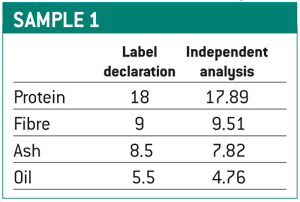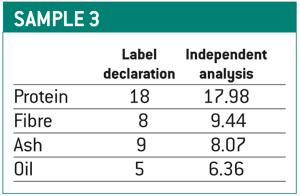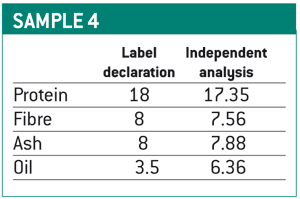Taking a close look at winter feed will pay off
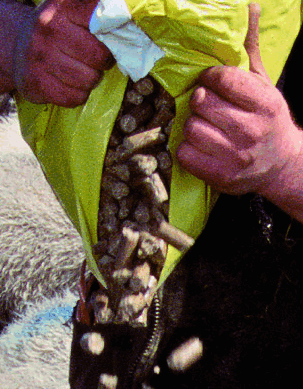
Sheep farmers planning to order winter rations in the next few weeks should avoid buying purely on price and ensure they check feed ingredients when ordering.
And a Farmers Weekly investigation shows it may be worth having feed samples analysed to ensure what they order is what they receive.
Of four random 18% protein ewe feed samples submitted for independent analysis by Farmers Weekly, two had protein content levels of 17.35% or below, with one returning just 17.04% for protein. This means the poorest analysed feed contained 5.3% less protein than was declared on the manufacturers’ analysis.
But despite farmers’ concerns that manufacturers may be sacrificing feed quality as input prices rise, these variations aren’t a major concern, explains ADAS sheep consultant Kate Philips.
“While these protein levels fail to match the manufacturers’ declarations, they are within the permitted variations. An 18% feed can contain up to 20% more protein than the declared level and up to 10% less. This means its protein content could range from 21.6% down to 16.2%.”
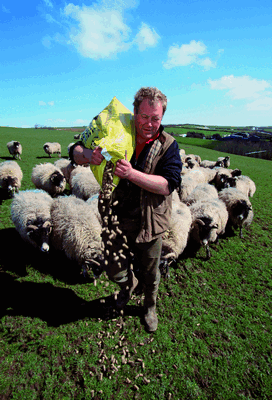 Most compound manufacturers are doing a good job of making feeds and it must be remembered that raw materials vary in quality and no analysis can be guaranteed 100% accurate, she explains. “And, while having concentrates analysed can be useful, analysing forages is far more important for most flocks.
Most compound manufacturers are doing a good job of making feeds and it must be remembered that raw materials vary in quality and no analysis can be guaranteed 100% accurate, she explains. “And, while having concentrates analysed can be useful, analysing forages is far more important for most flocks.
“Forages, particularly this year, are highly variable and concentrates will need to be balanced against whatever forage is being fed.”
It’s essential to match concentrate to forage quality and feeding system, she adds. “Even with feed prices rising, it is important to buy the best feed you can. Small savings of £3-4/t on concentrates may seem good, but really aren’t going to make or break a flock’s profitability. Spending a little bit more money on a top quality feed is worthwhile in the long-term.”
Equally important is having a good relationship with your manufacturers to ensure they know what you’re after in terms of feed and what your flock needs, explains Ms Philips. “When ewes are expecting multiple lambs, scrimping on feed is a false economy. But equally, when ewes are on a less productive system, a lower-quality feed may be appropriate.”
Independent sheep consultant Lesley Stubbings says there is no such thing as a cheap feed and that spending a little more money on a top-of-the-range product suited to flock needs will pay dividends.
“One of the best ways of monitoring feed quality is to check the ingredients. What you want to be seeing is reasonable levels of cereals for base energy content, then you’re looking for protein sources, ideally soya and maybe some beans.
“Wheatfeed is OK to use to balance rations and rapemeal is also a good source of protein, provided its balanced with something like molasses to provide the energy content. Importantly, oil levels shouldn’t be too high either. Oil increases the energy level in diets, but its not particularly usable energy for ruminants.”
Of the four samples analysed, just one exceeded Ms Stubbings’ recommended 5% oil inclusion rate. However, at 6.36% oil, it is significantly above the upper threshold she recommends. “I’d certainly be asking questions about the ingredients of this feed as it could be low in usable energy sources.”
Importantly, Ms Stubbings says, flockmasters should ensure manufacturers are working to relatively fixed formulations, as changes to ingredients can significantly affect palatability and hence intakes.
“Ingredients such as citrus pulp are fine when they are in rations consistently at similar levels, but suddenly including or removing it from feeds can mean sheep fail to eat, causing problems with body condition score and milk yield.”
And it is body condition which will be the vital indicator for many flocks this winter, with variable forages and farmers trying to limit costs.
Shepherds should consider every aspect of the feeding system, including whether ewes are fed concentrates and forage separately or a mixed ration and how they are fed, says Ms Philips.
“There can be many reasons for poor body condition or low milk yield and it is seldom just a problem with concentrate feed. Ensuring sufficient trough space is vital and ewes shouldn’t be fighting for space to eat.”
Farmers Weekly sheep feed sample analysis results (%)
